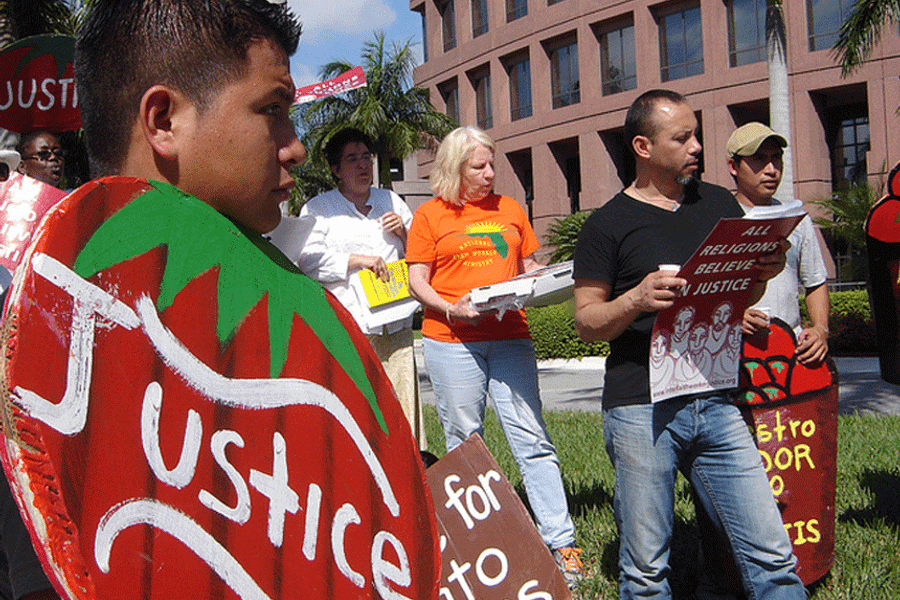
On Tuesday, the U.S. Chamber of Commerce released its second report in three months on worker centers. In it, the prominent pro-business lobbying group doubles down on its claim that the centers are “fronts” for established labor unions.
Worker centers often provide services to low-wage, immigrant and minority workers, and historically are involved in employment sectors or parts of the country with little union presence, according to Janice Fine, a professor of labor studies and employment relations at Rutgers University who has studied worker centers. The number of such centers nationally has climbed from a just a few two decades ago to upwards of 200 today, according to a Wall Street Journal July story.
The Chamber’s report charges that worker centers “create the appearance of a grassroots movement” with consumer boycotts and worker walkouts against employers like Walmart and Target, when they are really “formed and incubated by well-established and well-funded labor unions and foundations” (the previous Chamber study on worker centers focused on charitable foundation financing).
But while the Chamber shows that some worker centers have union ties, the report gives no evidence that either worker centers or unions are suppressing this fact.
“Conservative foundations fund conservative organizations and progressive foundations fund progressive organizations, news at eleven,” reads a statement in response to the report from the Florida-based Coalition of Immokalee Workers, one of five worker centers singled out in the Chamber’s study.
In addition to the financing issue, the Chamber claims worker centers use organized labor tactics, like work stoppages, while not facing the same financial and legal scrutiny as unions.
There is truth to this. David Moberg reported for In These Times in July that since worker centers are “unbound by decades of legal decisions that hem in unions, the low-wage workers’ associations are freer to use more innovative and militant tactics, such as strikes, which capture attention and enlarge the movement.”
In fact, AFL-CIO President Richard Trumka said last March that the union federation must collaborate more with worker centers (The AFL-CIO declined to comment for this story). So with the union-worker center relationship already established — and readily acknowledged by the largest labor federation in the county — what is the Chamber actually saying that’s new?
The study specifically looks at five groups: the Centro de Trabajadores Unidos En Lucha, the, Warehouse Workers United, Our WALMART, New York Communities for Change, and Coalition of Immokalee Workers.
Minneapolis’s Centro de Trabajadores Unidos en Lucha, or CTUL, part of the Chicago-based Interfaith Worker Justice network, is focused on janitors working for contractors of large corporations like Target. The CTUL “enjoys the support” of UFCW and SEIU labor unions, according to the report.
But Kim Bobo, Executive Director of Interfaith Worker Justice, says that is no secret. “Of course, we are partners with unions and foundations,” Bobo says. “We are also partners and allies with churches, mosques, and synagogues — and law firms.” Bobo says that unions and charitable foundations have both helped finance her organization’s work and collaborated on campaigns.
“Being a partner with someone means working with them,” Bobo says. “It’s not being a front for them.”
Meanwhile, in its look at Warehouse Workers United, the Chamber demonstrates explicit ties between the Southern California-based group and the Change to Win union coalition. With New York Communities for Change, or NYCC, the Chamber focuses on the group’s affiliation with 1199SEIU on the East Coast, a connection NYCC has made no discernible attempt to hide.
Perhaps the most curious part of the report is suggesting that OUR Walmart is creating the appearance of non-involvement with the United Food and Commercial Workers. The Chamber points out that UFCW created the organization in 2011 to specifically advocate for Walmart employees.
The group has since initiated several disruptions at Walmart stores — such as work stoppages on Black Friday, the post-Thanksgiving shopping blitz. In many instances, UFCW employees will help coordinate events as well as appear at protests and rallies — sometimes wearing UFCW apparel.
These ties between worker center and established, national union are undeniable, but no one has ever claimed otherwise. “They make it sound like a deep, dark secret that OUR Walmart is financed by UFCW, but everyone knows that,” Fine says.
Finally, the Chamber examines the Coalition of Immokalee Workers, or CIW, perhaps due to their public prominence from targeting restaurants and retailers that sell food grown by low-wage workers.
But CIW has no established ties to organized labor, though the Chamber plays up affiliations with outside faith-based and legal organizations since the start of the group’s existence. “This is just the same report issued by the Chamber months ago that announced the ‘finding’ that low wage worker organizations receive support from foundations,” reads the CIW statement in response to report. “That wasn’t news then, and it isn’t news now.”
As the New York Times examined in November, the Chamber and other business lobbyists have started to launch anti-worker center campaigns. The Chamber has formed a “Workforce Freedom Initiative” arm, partly targeted at worker centers: The initiative is the listed author of Tuesday’s report.
According to Fine, the Chamber’s strategy is to “tar worker centers with the same rhetoric that they’ve always tarred unions with” – namely that they are a special interest working against the country’s greater economic good.
The Chamber did not return requests for comment on this story.
“The tragedy,” Fine says, “is that the Chamber could be calling on its members to distinguish themselves” with better labor standards.







